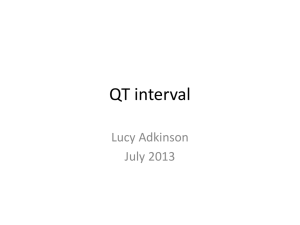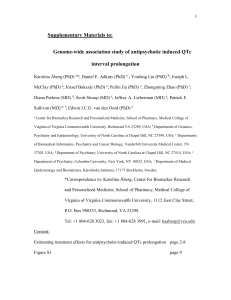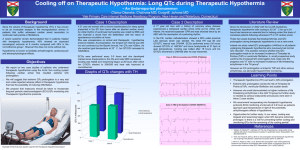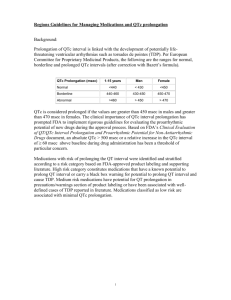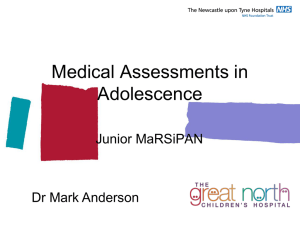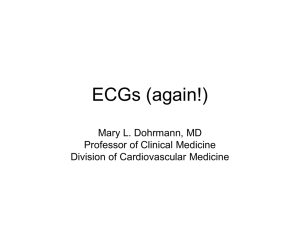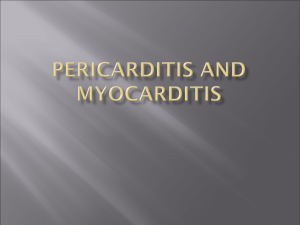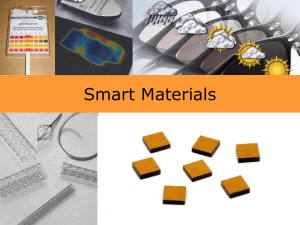QT_slides_V1.4_SF_MECL
advertisement
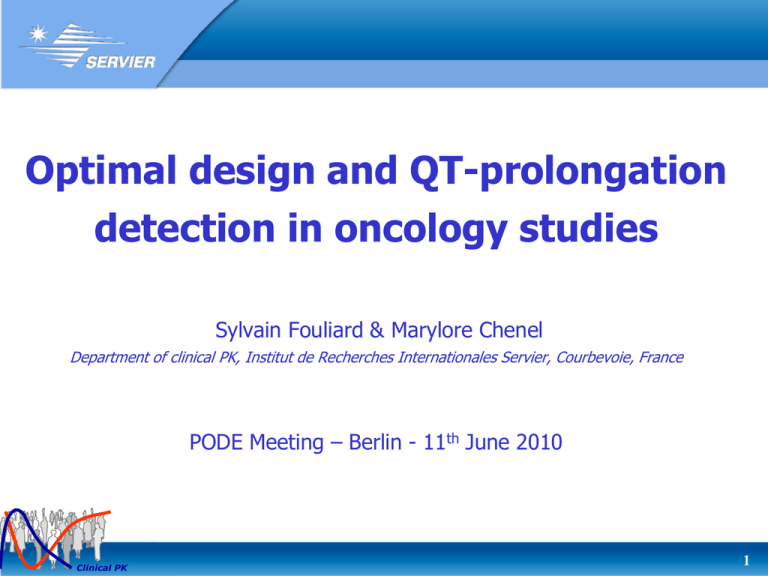
Optimal design and QT-prolongation
detection in oncology studies
Sylvain Fouliard & Marylore Chenel
Department of clinical PK, Institut de Recherches Internationales Servier, Courbevoie, France
PODE Meeting – Berlin - 11th June 2010
Clinical PK
1
CONTEXT (1)
• QT prolongation, a biomarker of Torsade de
Pointes.
• QT measured on ECG, then corrected.
• Circadian rythm in QT/QTc data
• Usually mandatory QT/QTC study performed
in healthy volunteers at supratherapeutic
dose
• Guidelines: mean QTc effect > 5ms
Clinical PK
2
CONTEXT (2)
• New anti-cancer drug in clinical development
- QTc-prolongation = class effect ?
• Development of anticancer drugs: patients only
• 2 phase I studies:
– PK data available population PK model
– No QT data available
• 2 ongoing phase I/II studies
- QTc-prolongation assessment: ECG measurement times
already decided without optimization (=empirical design)
• Internal QT database in HV (wo drug)
population
circadian QTc model available
Clinical PK
3
CONTEXT (3)
EMPIRICAL DESIGN
• 2 phase I clinical trials: n = 60 + 40 (=100) patients
• Dose regimen : 14 days on / 7 days off, BID administration (4h apart)
• 14 ECG measurements per patient
• Same measurement times for all patients
ECG
Dose
Inclusion D1
D2
D4
D14
Treatment
ECG times :
Inclusion
0
Clinical PK
D1
D2
D4
0, 1.5,
0, 1.5h 0, 1.5h
4, 5.5, 8 h
D22
No Treatment
D14
0, 1.5h
D22
0, 1.5h
4
OBJECTIVES
1. Evaluate the Empirical design for ECG
Times.
2. Calculate the Power of detection of a
QTc effect in the on going phase I/II
studies.
3. Optimize the ECG Measurement Times
for future studies.
Clinical PK
5
MATERIALS & METHODS (1)
POPULATION QTc MODEL WITHOUT DRUG
Assumption: same model to describe the circadian rhythm in QTc in HV and in patients
• Model building dataset: 2 thorough QT/QTc studies
- 62 + 87 (=149) healthy volunteers
- QT data without drug
- Fredericia correction: QTc = QT * HR-0.33
t QTLn
QTc t QTM 0 1 QTAn cos
n 1
24
/
2
n1, 2,3
• Model characteristics
- poly-cosine model [1]
- IIV on all parameters
- Additive error model
• Software (estimation method):
- NONMEM VI (FOCEI)
QTc
(ms)
…
Median
5% - 95 % CI
Observations
• Criteria : LRT
• Evaluation: GOF, RSE, VPC
Clinical PK
Time (h)
[1] Piotrovsky, V. “Pharmacokinetic-pharmacodynamic modeling in the data analysis
and interpretation of drug-induced QT/QTc prolongation” (2005)
6
MATERIALS & METHODS (2)
POPULATION QTc MODEL WITH DRUG EFFECT
Assumptions:
• Same model to describe the circadian rhythm in QTc in
HV and in patients
• Concentration proportional drug effect on Mesor
QTM t QTM0 1 Ct
t QTLn
QTc t QTM (t ) 1 QTAn cos
n 1
24
/
2
n1, 2,3
• QTc-prolongation is measured by :
QTc t QTM0 C(t )
• Max QTc-prolongation at Cmax (PKPD model)
Clinical PK
7
MATERIALS & METHODS (3)
POPULATION PK MODEL
• Model building dataset: 2 phase 1 studies
- 14 patients, IV multiple doses, oral single dose
- 35 patients, oral multiple doses
F
Ka
• Model characteristics:
- 3-compartments model
- First order absorption and elimination
Periph. 1
Q2
(V2)
- IIV on Ka, F, CL, V1, V2
Central
(V1)
Q3
Periph. 2
(V3)
CL
- Combined error model
• Software (estimation method): NONMEM VI (FOCEI)
• Criteria : LRT
• Evaluation: GOF, RSE, VPC
more
Clinical PK
8
MATERIALS & METHODS (5)
CALCULATION OF FISHER INFORMATION MATRIX
Sequential pop PKPD modelling
PK model
PK parameters
QTc model without treatment
(not estimated)
Mesor,
3 Cosine amplitude terms
Drug effect
3 Cosine Lagtime
γ
(estimated)
(estimated)
QTc model under treatment
8 parameters + Additive error
QTM0, QTA1, QTA2, QTA3, QTL1, QTL2, QTL3, γ
Clinical PK
9
MATERIALS & METHODS (6)
EVALUATION OF THE EMPIRICAL DESIGN
To find the range of relevant γ values corresponding to a range of
relevant QTc prolongations
QTc t QTM0 C(t )
Range of relevant
QTc-prolongation values
Range of relevant γ values
[1 ms, 100ms]
[0.01, 1]
• Calculation of the population Fisher Information Matrix
–
–
–
Parameters of QTc model without drug
γ = {0. 01, 0.02, 0.05, 0.1, 0.15, 0.2, 0.3, 0.4, 0.5, 0.8, 1}
IIV on γ = 30 %
• Output results:
–
Clinical PK
SE, RSE, DET (determinant of the population FIM)
10
MATERIALS & METHODS (7)
POWER DETECTION OF DRUG EFFECT
For each value of γ, SE(γ) is computed from FIM
Wald test is performed, with a 5 % type I error.
SE( )
- Null hypothesis H0 :
~ N ( 0 ,1)
no QTc effect of the drug, 0 = 0
- Alternative hypothesis H1:
QTc effect of the drug,
0 > 0
Then power is computed from the type II error β.
Power = 1- β.
1
95%
Clinical PK
0
0
1
1
11
MATERIALS & METHODS (8)
ECG DESIGN OPTIMIZATION
• Design characteristics :
- 1 group of patients
- = 0.05, 30 % IIV
- Same days* & number of measurement per day* as the empirical design,
design domain = [0-10h] for D1
= [0-8h]
for each other ECG measurement day
5 ECG on D1, 2
ECG on D2, 2 ECG
on D4, 2 ECG on
D14, 2 ECG on D22
*
• Output results :
– Optimal ECG times
– SE, RSE, DET (determinant of the population FIM)
Clinical PK
12
MATERIALS & METHODS (9)
• Software:
- PopDes [2], version 3.0 under MATLAB
• Design options:
-Local, Population, Univariate (design variable = ECG
measurement time only, i.e. PK fixed)
• Optimisation method: Fedorov Exchange
• Criteria : D-Optimality
[2] Gueorguieva, K. Ogungbenro, G. Graham, S. Glatt, and L. Aarons. A program for individual and population optimal design for
univariate and multivariate response pharmacokinetic and pharmacodynamic models. Comput. Methods Programs Biomed. 86(1):
51-61 (2007)
Clinical PK
13
RESULTS (1)
EMPIRICAL DESIGN EVALUATION (1)
1
QTM0
QTA1
QTL1
10
QTA2
QTL2
QTA3
1
QTL3
SE (gamma)
RSE (%) of fixed effects
param.
100
0.1
0.01
0.001
0.1
0.01
0.1
Gamma value
1
0.01
0.1
1
Gamma value
Whatever the values (i.e. drug effect), there is low impact on the
RSEs of baseline QTc model parameters.
SE() increases with ; RSE is below 20 % for
> 0.05 (QTc-prolongation of 5 ms).
Clinical PK
14
RESULTS (2)
EMPIRICAL DESIGN EVALUATION (2)
RSE of QTc model parameters for a drug effect () of 0.05 (corresponding to a
QTc prolongation of about 5 ms).
RSE (%)
QTM0
(ms)
QTA1
QTA2
QTA3
QTL1
(hr)
QTL2
(hr)
QTL3
(hr)
Add_Err
(ms)
0.37
27.1
8.4
10.8
5.9
13.6
2.9
4.85
11.7
The RSEs of QTc model parameters are always lower than 20%
for fixed effects, except for QTA1, for which there are around
25%.
Clinical PK
15
RESULTS (3)
POWER DETECTION OF DRUG EFFECT
Power of drug effect detection versus value (drug effect size)
Power
1
Série1
0
0.01
0.1
1
10
Gamma
Power > 90 % for > 0.02, corresponding to a 2 ms average QTcprolongation.
Clinical PK
16
RESULTS (4)
ECG TIME OPTIMIZATION (1)
RSE comparison for each parameter of the empirical and the optimal designs
Empirical design (Det = 2.37 x 1040)
QTA3
QTL1
(hr)
QTL2
(hr)
QTL3
(hr)
Add_Err
(ms)
0.37
27.1
8.4
10.8
Optimal design (Det = 2.22 x 1064)
5.9
13.6
2.9
4.85
11.7
QTM0
(ms)
QTA1
QTA2
RSE (%)
RSE (%)
QTM0
QTA1
QTA2
QTA3
QTL1
QTL2
QTL3
Add_Err
0.29
8.99
3.35
3.49
1.64
0.37
0.66
5.25
0.26
Sampling times :
D1
D2
D4
D14
D22
Phase I/II design 0, 1.5, 4, 5.5, 8h
0, 1.5h
0, 1.5h
0, 1.5h
0, 1.5h
Optimized design 4, 8, 8.2, 8.8, 9.6h
1.5, 5.6h 3.8, 5.2h
0, 0.6h
1, 1.5h
The optimal design is better than the empirical one, especially for
QTA1.
Clinical PK
17
CONCLUSIONS
INTERESTS & LIMITS
This work reassured us on the
capability of the empirical
design to detect any potential
drug effect.
The empirical design should
allow an accurate estimation
of the parameters of the QTc
model under treatment.
Clinical PK
Several
assumptions
have
been made clinicians not
ready yet to have an adaptive
design within a study.
18
CONCLUSIONS (2)
NEXT STEPS
• Assumptions made will be challenged with first
clinical data coming.
– PK model
– QTc baseline model parameter values
– Linear drug effect
• Optimization of the ECG measurement times with
different clinical constraints (days, times, number
of group, doses, number of measurements) for
further studies.
• Interest in having an integrated tool for
estimation and optimization.
Clinical PK
19
ACKNOWLEDGMENT
Sylvain Fouliard
pharmacometrician at Servier
France Mentré
Clinical PK
20
BACK-UP
Clinical PK
21
RESULTS
MODEL BUILDING
Population PK model
Parameter estimates and RSE of the population PK model
Parameter
CL
KA
F
V1
V2
V3
Q2
Q3
ErrA
ErrP
Estimates
(RSE %)
54
(10.1)
0.74
(12)
0.30
(10.3)
45
(14.6)
630
(11.7)
61
(11.7)
12
(12.8)
35
(12.8)
0.0092
(32.2)
0.31
(6.36)
IIV
(RSE %)
0.114
(38.8)
0.342
(32.2)
0.277
(28)
0.202
(35.5)
.
0.143
(46.9)
.
.
Back
Clinical PK
22
RESULTS
MODEL EVALUATION
Population PK model
Normalized
dose
Visual predictive checks
Normal scale
Log scale
Time (h)
…
Clinical PK
Median
5% - 95 % CI
Back
Observations
23
RESULTS
MODEL EVALUATION
Population PK model
Numerical predictive checks
Observed Values compared to Simulated Confidence Interval
CI
Obs below
CI (%)
Obs in CI
(%)
Obs above
CI (%)
MEDIAN
61.1
.
38.8
[P1-P99]
1.7
97.6
0
[P5-P95]
6.1
91.7
2.2
[P10-P90]
10.4
85.3
4.3
[P25-P75]
26.4
60.2
13.4
Back
Clinical PK
24
RESULTS
MODEL BUILDING
Baseline poly-cosine QTc model
Parameter estimates and RSE of the baseline poly-cosine QTc model
Parameter
QTM0
(ms)
QTA1
QTL1
(hr)
QTA2
QTL2
(hr)
QTA3
QTL3
(hr)
ErrA
(ms)
Estimates
(RSE %)
400
(0.214)
0.011
(12)
12
(1.98)
0.0103
(7.75)
7.66
(1.04)
0.0073
(3.8)
5.73
(0.61)
5.35
(2.5)
IIV
(RSE %)
0.0008
(10.7)
0.084
(32.3)
2.4
(24.3)
0.029
(43.2)
0.488
(26.2)
0.047
(40.9)
0.091
(23.7)
.
Back
Clinical PK
25
RESULTS
MODEL EVALUATION
Baseline poly-cosine QTc model
Visual predictive checks
QTc
(ms)
Median
…
5% - 95 % CI
Observations
Time (h)
Back
Clinical PK
26
RESULTS
MODEL EVALUATION
Baseline poly-cosine QTc model
Numerical predictive checks
Observed Values compared to Simulated Confidence Interval
CI
Obs below CI (%)
Obs in CI
(%)
Obs above CI (%)
MEDIAN
49.2
.
50.8
[P1-P99]
0.6
97.6
1.8
[P5-P95]
3.8
90.6
5.6
[P10-P90]
9.4
80.6
10
[P25-P75]
23.3
51.9
24.8
Back
Clinical PK
27
CONTEXT (1’)
• P wave: auricular depolarisation
• QRS complex: ventricular depolarisation
• T wave: auricular repolarisation
Clinical PK
28
CONTEXT (1’’)
• Relationship between QT and RR (=60/HR1000)
QT versus RR AT BASELINE
ALL DATA
QT CORRECTION AT BASELINE
ALL DATA
QTc vs. RR
475
450
450
425
QTc_BASELINE (msec)
QT_BASELINE (msec)
QT vs. RR
425
400
375
350
400
375
350
325
325
300
300
500
750
1000
1250
RR (msec)
1500
1750
500
750
1000
1250
RR (msec)
1500
1750
• Compare QT before and after treatment, once QT
is corrected for HR (QTc)
Clinical PK
29
